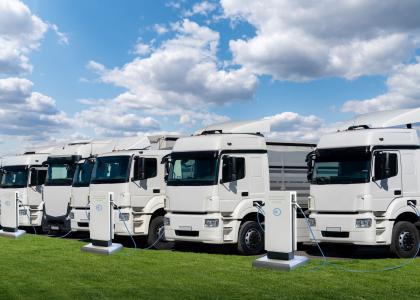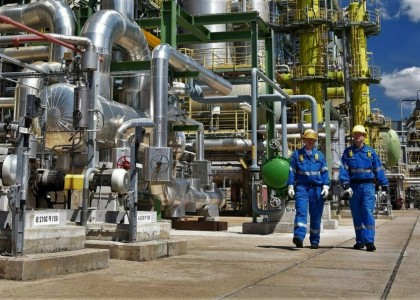To address climate change, an increasing number of companies—more than 1,100 so far—have recently set science-based targets (SBTs) for greenhouse gas (GHG) reductions. Given the exigency of the climate crisis, companies need to not only set robust goals but also achieve them. While a lot of information is available on how to set SBTs, there is surprisingly little on how to achieve them. As part of ACEEE’s Industrial Decarbonization Initiative, this post examines how companies can pursue these goals while delivering for their business, value chain partners, and the planet.
First though, some brief background on SBTs. They are clearly defined targets for companies to reduce GHG emissions and prevent the worst impacts of climate change. SBTs align with Paris Climate Agreement commitments to limit the rise of global temperatures to less than 2ºC above pre-industrial levels and to push for more stringent limits on this warming to 1.5ºC. They can also increase a company’s long-term value, because they help build business resilience, boost investor confidence, drive innovation, manage credibility and reputation, and prepare for changes in public policy.
Manufacturing companies across sectors are setting SBTs, many as part of their sustainability goals, in response to customer, investor, and employee demands. For example, in cement, LaFarge Holcim has set SBTs and is pursuing them with a combination of recycling, fuel switching, and supply chain partnerships. Taiwan Cement is pursuing SBTs via renewable energy, waste recovery, energy efficiency, alternative materials, and biofuels. Here are examples of other companies taking action on the road to SBTs, by sector:
Steel: Cleveland Cliffs is using energy management, cleaner fuels, and innovative process technology to exceed GHG reduction targets.
Chemicals: Twenty-five companies have set carbon reduction targets, including nine that have set goals to be net-zero energy by 2050. For example, DuPont has committed to GHG reductions of 30% by 2030 using more electricity from renewables, energy efficiency, and low-carbon processes. And Eastman Chemical recently set ambitious reduction goals aiming to decrease carbon emissions 80% by 2050, including developing a strategy to address indirect emissions throughout the supply chain.
Food processing: PepsiCo has committed to reduce absolute scope 1 and 2 GHG emissions by 75% and scope 3 GHG emissions by 40% by 2030 through energy efficiency, reduced supply chain emissions, and material efficiency. General Mills has committed to reducing absolute scope 1, 2, and 3 emissions 30% by 2030 through reduced food waste, lower-impact packaging, and energy efficiency. (Scope 1 emissions are direct emissions from plants, scope 2 are emissions from upstream power generation, and scope 3 are emissions throughout the supply chain.)
Oil and gas: Halliburton and Schlumberger Limited have announced that they plan to set SBTs this year.
Paper: Timberlink has committed to a 53% reduction in GHG emissions by 2030 via renewable electricity.
Glass: O-I Glass, Inc. has committed to reduce absolute scope 1, 2, and 3 GHG emissions 25% by 2030.
How to achieve these targets:
As with any goals, SBTs need to be SMART (specific, measurable, actionable, realistic, timely). Yet, because they call for big step-change reductions in GHG emissions, they’re outside the recent experience of many organizations. Companies may have made excellent progress in recent decades improving energy efficiency, reducing waste, and cutting emissions, but substantially greater reductions are needed, because analysis shows that projected GHG emissions remain well above the 2ºC scenario, let alone the 1.5ºC scenario.
To put a marker on the magnitude of reductions needed, consider that even with the COVID-19-induced drop in GHG emissions, the level of reduction needed by 2050 to reach the 2 °C scenario is 10 times greater than the GHG emissions drop from the pandemic-led recession. So, we have a lot of work to do. The good news: It’s possible to reach these goals without slowing down the economy, but it won’t be easy, and EVERYONE will need to contribute.
With industry accounting for more than 25% of GHG emissions in the United States, it will play a crucial role in slashing emissions, while also meeting increasing societal demands for innovative, lower-carbon products. Recent reports, including those by ACEEE and CERES, describe pathways for industrial decarbonization such as beneficial electrification. To help teams at manufacturing companies start and proactively pursue their SBTs, here are 10 action paths to consider.
Top 10 Action Paths to Achieve SBTs:
1. Assign senior management responsibility for making progress, tie compensation to performance, and set up regular updates.
2. Develop a strategy or roadmap and an action plan. Align it with business objectives, customer needs, technologies, etc. best suited to your company's industry. Break the goal into manageable subgoals (near, mid-, and longer-term).
3. Develop a portfolio of projects that includes a healthy dose of energy efficiency projects. Efficiency is often the most cost-effective, ready-to implement, multiple-benefit pathway that could get society halfway to CO2 reduction goals by 2050. Look for opportunities to recycle and reduce waste.
4. Look for synergies and business value and develop an expansive perspective to justify project economics (e.g., energy and non-energy benefits, customer value) to drive toward the goals.
5. Build a network of internal proponents. Build a culture where the network relentlessly seeks and pursues energy and GHG reduction opportunities. Initiate an energy management program (e.g., strategic energy management (SEM), ISO 50001, ISO 50001 Ready) that strives for continuous improvement, as explained in a previous blog post on SEM. One example is Eastman’s Worldwide Energy Management Team, where external partners contribute to Eastman’s 1/3 reduction of absolute GHG emissions by 2030 through aggressive energy management.
6. Connect with peers, experts, and innovators to leverage learnings. DOE’s Better Plants program and the Industrial Assessment Centers (IACs) are two key resources.
7. Map the value chain, identify the opportunities for the greatest GHG reduction potential, work with partners to pursue those reductions, and pursue value/synergies. This is particularly important as SBTs drive for impacts and targets along the supply chain.
8. Identify emerging and transformative process technology and new low-carbon approaches that fit your customer and industry needs. Switch energy sources to lower-carbon alternatives, including renewable energy and biofuels/biomass and investigate options for low-carbon processes in your company.
9. Collaborate on pilots/demos to advance technology, economics, implementation, and performance and implement the best options.
10. Evaluate the carbon intensity of the top company products and strive to continuously reduce the product carbon intensity. Gain experience differentiating the lower-carbon products with customers.
Setting SBTs is a growing trend in the corporate world with a strong connection to sustainability goals, investor interests, ability to future-proof growth, and reduce risks. Although the steep GHG reductions required for SBTs are challenging, there are numerous benefits and multiple paths for pursuing these goals. The top 10 action steps above are proactive paths for pursuing these goals with a durable approach for near- AND longer-term progress.





